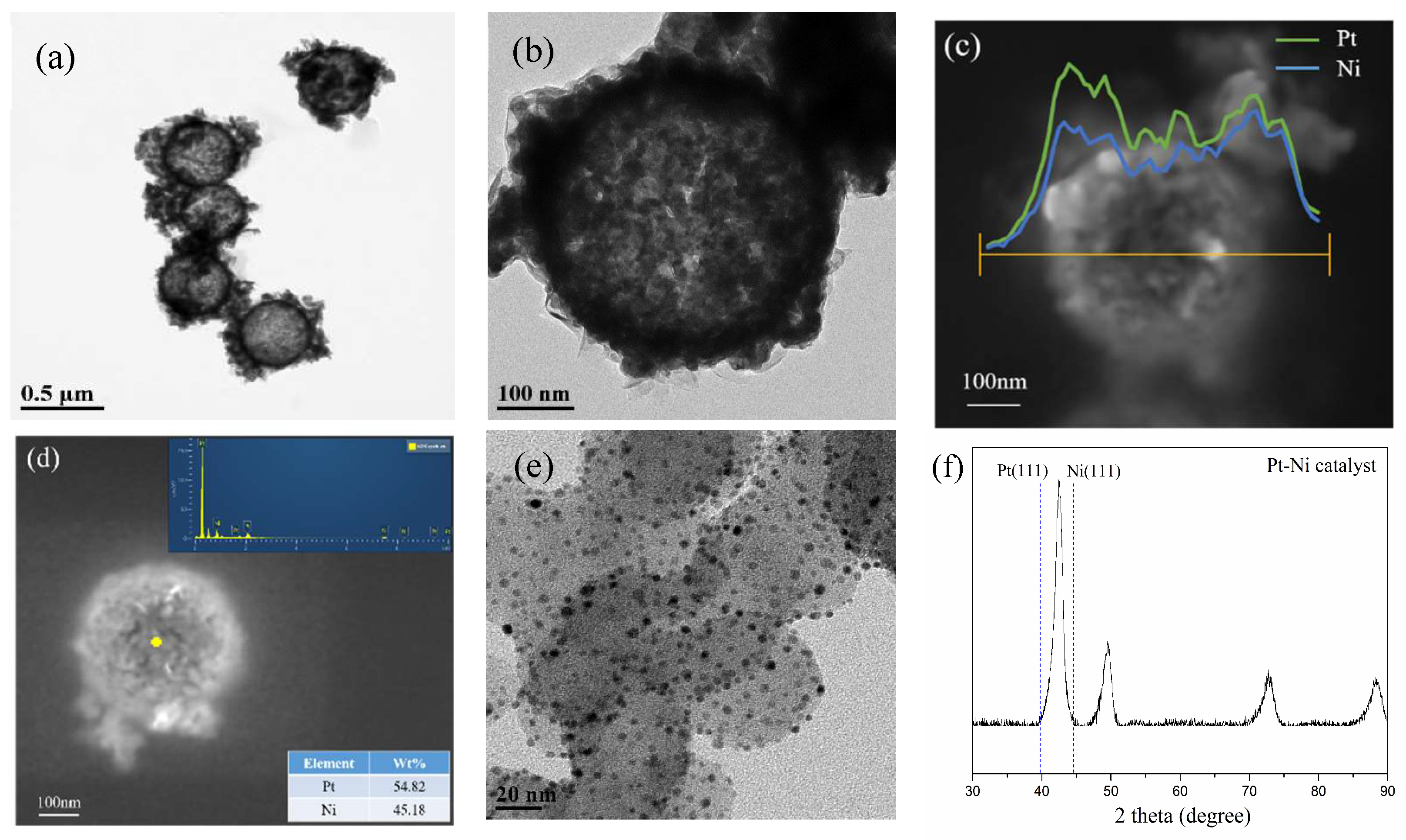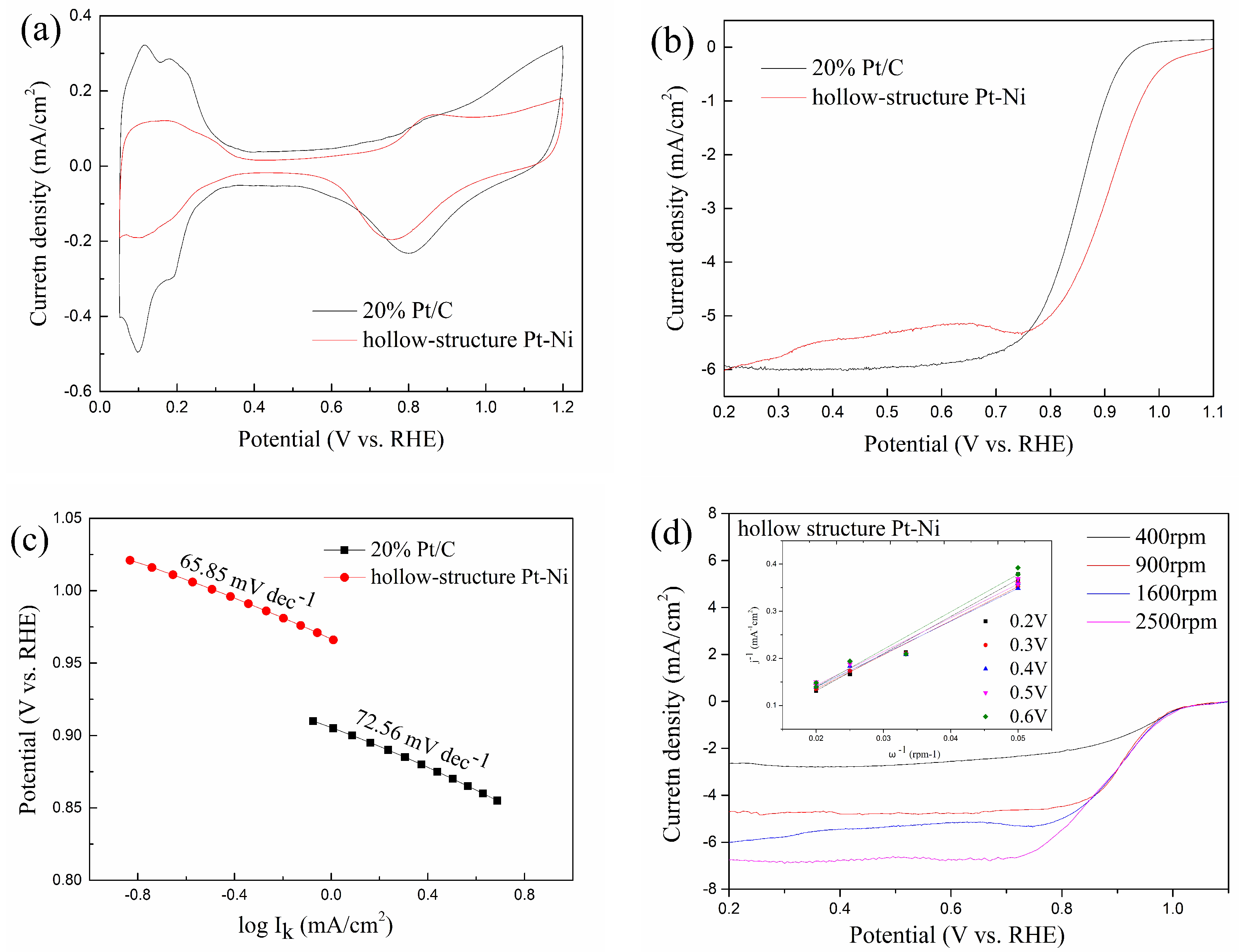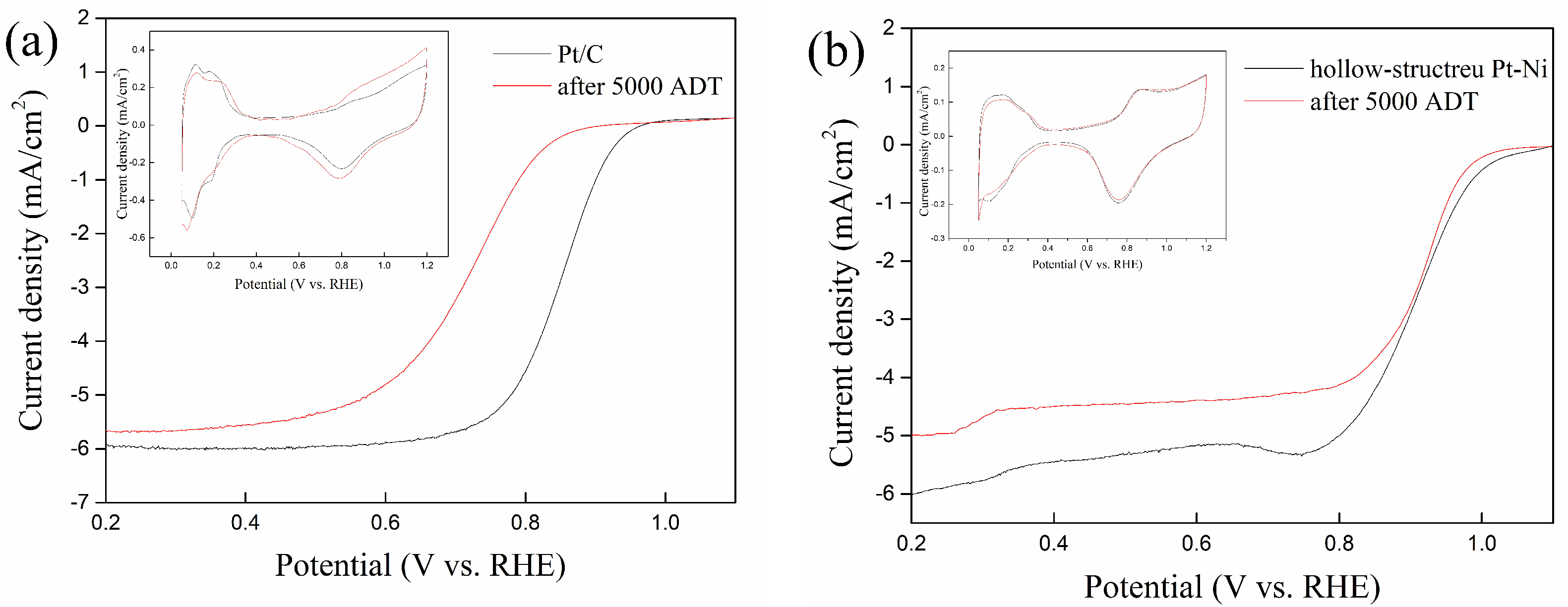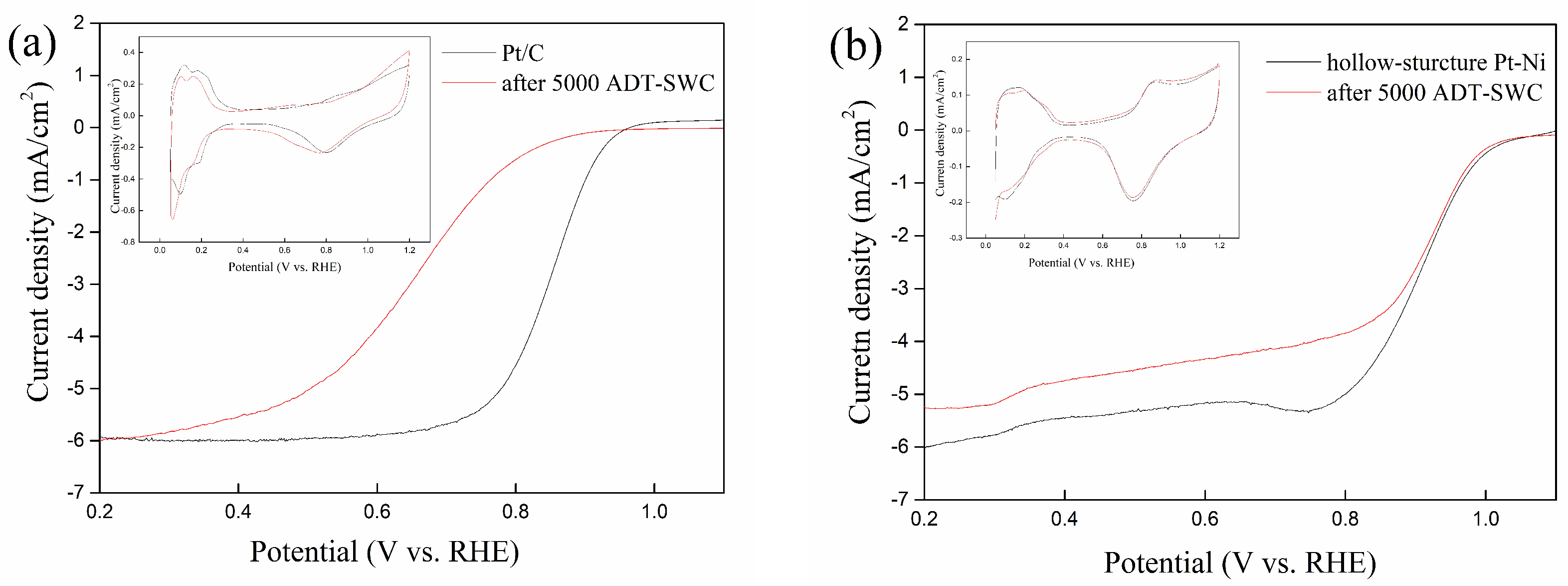Hollow-Structure Pt-Ni Nanoparticle Electrocatalysts for Oxygen Reduction Reaction
Abstract
:1. Introduction
2. Results and Discussion
2.1. Structure and Characterization of Pt-Ni Electrocatalyst
2.2. Electrochemical Characterization Analysis
2.3. Electrocatalysts Durability Analysis by Electrochemical Method
3. Materials and Methods
3.1. Materials
3.2. Synthesis of Hollow-Structure Pt-Ni Nanoparticles
3.3. Electrocatalyst Physical Characterization
3.4. Electrochemical Characterization
3.5. Electrocatalyst Durability Characterization
4. Conclusions
Author Contributions
Funding
Institutional Review Board Statement
Informed Consent Statement
Data Availability Statement
Acknowledgments
Conflicts of Interest
Sample Availability
References
- Zheng, Y.; Jiao, Y.; Vasileff, A.; Qiao, S.Z. The Hydrogen Evolution Reaction in Alkaline Solution: From Theory, Single Crystal Models, to Practical Electrocatalysts. Angew Chem. Int. Edit. 2018, 57, 7568–7579. [Google Scholar] [CrossRef] [PubMed]
- Debe, M.K. Electrocatalyst approaches and challenges for automotive fuel cells. Nature 2012, 486, 43–51. [Google Scholar] [CrossRef] [PubMed]
- Greeley, J.; Stephens, I.E.L.; Bondarenko, A.S.; Johansson, T.P.; Hansen, H.A.; Jaramillo, T.F.; Rossmeisl, J.; Chorkendorff, I.; Norskov, J.K. Alloys of platinum and early transition metals as oxygen reduction electrocatalysts. Nat. Chem. 2009, 1, 552–556. [Google Scholar] [CrossRef]
- Muto, M.; Nagayama, M.; Sasaki, K.; Hayashi, A. Development of Porous Pt Electrocatalysts for Oxygen Reduction and Evolution Reactions. Molecules 2020, 25, 2398. [Google Scholar] [CrossRef] [PubMed]
- Feng, Y.; Liu, H.; Wang, P.F.; Ye, F.; Tan, Q.Q.; Yang, J. Enhancing the Electrocatalytic Property of Hollow Structured Platinum Nanoparticles for Methanol Oxidation Through A Hybrid Construction. Sci. Rep. 2014, 4, 6204. [Google Scholar] [CrossRef] [Green Version]
- Shen, C.; Li, X.; Wei, Y.; Cao, Z.; Li, H.; Jiang, Y.; Xie, Z. PtCo-excavated rhombic dodecahedral nanocrystals for efficient electrocatalysis. Nanoscale Adv. 2020, 2, 4881–4886. [Google Scholar] [CrossRef]
- Li, H.H.; Ma, S.Y.; Fu, Q.Q.; Liu, X.J.; Wu, L.; Yu, S.H. Scalable Bromide-Triggered Synthesis of Pd@Pt Core-Shell Ultrathin Nanowires with Enhanced Electrocatalytic Performance toward Oxygen Reduction Reaction. J. Am. Chem. Soc. 2015, 137, 7862–7868. [Google Scholar] [CrossRef]
- Ye, W.; Chen, S.; Ye, M.; Ren, C.; Ma, J.; Long, R.; Wang, C.; Yang, J.; Song, L.; Xiong, Y. Pt4PdCu0.4 alloy nanoframes as highly efficient and robust bifunctional electrocatalysts for oxygen reduction reaction and formic acid oxidation. Nano Energy 2017, 39, 532–538. [Google Scholar] [CrossRef]
- Nakamoto, T.; Motomiya, K.I.; Yokoyama, S.; Takahashi, H. Precursor-templated synthesis of thermodynamically unfavored platinum nanoplates for the oxygen reduction reaction. Dalton Trans. 2020, 49, 15837–15842. [Google Scholar] [CrossRef]
- Hashimasa, Y.; Shimizu, T.; Matsuda, Y.; Imamura, D.; Akai, M. Verification of Durability Test Methods of an MEA for Automotive Application. ECS Trans. 2012, 50, 723–732. [Google Scholar] [CrossRef]
- Tamaki, T.; Kuroki, H.; Ogura, S.; Fuchigami, T.; Kitamoto, Y.; Yamaguchi, T. Connected nanoparticle catalysts possessing a porous, hollow capsule structure as carbon-free electrocatalysts for oxygen reduction in polymer electrolyte fuel cells. Energ Environ. Sci. 2015, 8, 3545–3549. [Google Scholar] [CrossRef] [Green Version]
- Esfahani, R.A.M.; Vankova, S.K.; Videla, A.H.A.M.; Specchia, S. Innovative carbon-free low content Pt catalyst supported on Mo-doped titanium suboxide (Ti3O5-Mo) for stable and durable oxygen reduction reaction. Appl. Cataly. B-Environ. 2017, 201, 419–429. [Google Scholar] [CrossRef]
- Hussain, S.; Erikson, H.; Kongi, N.; Tarre, A.; Ritslaid, P.; Kikas, A.; Kisand, V.; Kozlova, J.; Aarik, J.; Tamm, A.; et al. Platinum Sputtered on Nb-doped TiO2 Films Prepared by ALD: Highly Active and Durable Carbon-free ORR Electrocatalyst. J. Electrochem. Soc. 2020, 167, 164505. [Google Scholar] [CrossRef]
- Takasaki, F.; Matsuie, S.; Takabatake, Y.; Noda, Z.; Hayashi, A.; Shiratori, Y.; Ito, K.; Sasaki, K. Carbon-Free Pt Electrocatalysts Supported on SnO2 for Polymer Electrolyte Fuel Cells: Electrocatalytic Activity and Durability. J. Electrochem. Soc. 2011, 158, B1270–B1275. [Google Scholar] [CrossRef]
- Wang, D.; Xin, H.L.; Hovden, R.; Wang, H.; Yu, Y.; Muller, D.A.; DiSalvo, F.J.; Abruna, H.D. Structurally ordered intermetallic platinum-cobalt core-shell nanoparticles with enhanced activity and stability as oxygen reduction electrocatalysts. Nat. Mater. 2013, 12, 81–87. [Google Scholar] [CrossRef]
- Gan, L.; Heggen, M.; Rudi, S.; Strasser, P. Core-shell compositional fine structures of dealloyed Pt(x)Ni(1-x) nanoparticles and their impact on oxygen reduction catalysis. Nano Lett. 2012, 12, 5423–5430. [Google Scholar] [CrossRef]
- Chen, C.; Kang, Y.J.; Huo, Z.Y.; Zhu, Z.W.; Huang, W.Y.; Xin, H.L.L.; Snyder, J.D.; Li, D.G.; Herron, J.A.; Mavrikakis, M.; et al. Highly Crystalline Multimetallic Nanoframes with Three-Dimensional Electrocatalytic Surfaces. Science 2014, 343, 1339–1343. [Google Scholar] [CrossRef]
- Huang, X.Q.; Zhao, Z.P.; Cao, L.; Chen, Y.; Zhu, E.B.; Lin, Z.Y.; Li, M.F.; Yan, A.M.; Zettl, A.; Wang, Y.M.; et al. High-performance transition metal-doped Pt3Ni octahedra for oxygen reduction reaction. Science 2015, 348, 1230–1234. [Google Scholar] [CrossRef] [Green Version]
- Ahmadi, M.; Cui, C.H.; Mistry, H.; Strasser, P.; Roldan Cuenya, B. Carbon Monoxide-Induced Stability and Atomic Segregation Phenomena in Shape-Selected Octahedral PtNi Nanoparticles. ACS Nano 2015, 9, 10686–10694. [Google Scholar] [CrossRef]
- Xu, S.C.; Walter, E.D.; Zhao, Z.C.; Hu, M.Y.; Han, X.W.; Hu, J.Z.; Bao, X.H. Dynamic Structural Changes of SiO2 Supported Pt-Ni Bimetallic Catalysts over Redox Treatments Revealed by NMR and EPR. J. Phys. Chem. C 2015, 119, 21219–21226. [Google Scholar] [CrossRef]
- Kitchin, J.R.; Norskov, J.K.; Barteau, M.A.; Chen, J.G. Modification of the surface electronic and chemical properties of Pt(111) by subsurface 3d transition metals. J. Chem. Phys. 2004, 120, 10240–10246. [Google Scholar] [CrossRef] [Green Version]
- Mistry, H.; Varela, A.S.; Kuhl, S.; Strasser, P.; Roldan Cuenya, B. Nanostructured electrocatalysts with tunable activity and selectivity. Nat. Rev. Mater. 2016, 1, 1–14. [Google Scholar] [CrossRef]
- Mavrikakis, M.; Hammer, B.; Norskov, J.K. Effect of strain on the reactivity of metal surfaces. Phys. Rev. Lett. 1998, 81, 2819–2822. [Google Scholar] [CrossRef] [Green Version]
- Toda, T.; Igarashi, H.; Uchida, H.; Watanabe, M. Enhancement of the electroreduction of oxygen on Pt alloys with Fe, Ni, and Co. J. Electrochem. Soc. 1999, 146, 3750–3756. [Google Scholar] [CrossRef]
- Mukerjee, S.; Srinivasan, S.; Soriage, M.P.; McBreen, J. Role of Structural and Electronic Properties of Pt and Pt Alloys on Electrocatalysis of Oxygen Reduction: An In Situ XANES and EXAFS Investigation. J. Electrochem. Soc. 1995, 142, 1409–1422. [Google Scholar] [CrossRef]
- Schmidt, T.J.; Gasteiger, H.A.; Stäb, G.D.; Urban, P.M.; Kolb, D.M.; Behm, R.J. Characterization of high-surface-area electrocatalysts using a rotating disk electrode configuration. J. Electrochem. Soc. 1998, 145, 2354–2358. [Google Scholar] [CrossRef]
- Garsany, Y.; Ge, J.; St-Pierre, J.; Rocheleau, R.; Swider-Lyons, K.E. Analytical Procedure for Accurate Comparison of Rotating Disk Electrode Results for the Oxygen Reduction Activity of Pt/C. J. Electrochem. Soc. 2014, 161, F628–F640. [Google Scholar] [CrossRef]
- Zhao, X.; Hayashi, A.; Noda, Z.; Kimijima, K.I.; Yagi, I.; Sasaki, K. Evaluation of change in nanostructure through the heat treatment of carbon materials and their durability for the start/stop operation of polymer electrolyte fuel cells. Electrochim. Acta 2013, 97, 33–41. [Google Scholar] [CrossRef]
- Jeon, M.K.; Zhang, Y.A.; McGinn, P.J. A comparative study of PtCo, PtCr, and PtCoCr catalysts for oxygen electro-reduction reaction. Electrochim. Acta 2010, 55, 5318–5325. [Google Scholar] [CrossRef]
- van der Vliet, D.F.; Wang, C.; Tripkovic, D.; Strmcnik, D.; Zhang, X.F.; Debe, M.K.; Atanasoski, R.T.; Markovic, N.M.; Stamenkovic, V.R. Mesostructured thin films as electrocatalysts with tunable composition and surface morphology. Nat. Mater. 2012, 11, 1051–1058. [Google Scholar] [CrossRef]
- Markovic, N.M.; Gasteiger, H.A.; Grgur, B.N.; Ross, P.N. Oxygen reduction reaction on Pt(111): Effects of bromide. J. Electroanal. Chem. 1999, 467, 157–163. [Google Scholar] [CrossRef]
- Komanicky, V.; Menzel, A.; You, H. Investigation of oxygen reduction reaction kinetics at (111)-(100) nanofaceted platinum surfaces in acidic media. J. Phys. Chem. B 2005, 109, 23550–23557. [Google Scholar] [CrossRef] [PubMed]
- Paulus, U.A.; Wokaun, A.; Scherer, G.G.; Schmidt, T.J.; Stamenkovic, V.; Radmilovic, V.; Markovic, N.M.; Ross, P.N. Oxygen reduction on carbon-supported Pt-Ni and Pt-Co alloy catalysts. J. Phys. Chem. B 2002, 106, 4181–4191. [Google Scholar] [CrossRef]
- Norskov, J.K.; Rossmeisl, J.; Logadottir, A.; Lindqvist, L.; Kitchin, J.R.; Bligaard, T.; Jonsson, H. Origin of the overpotential for oxygen reduction at a fuel-cell cathode. J. Phys. Chem. B. 2004, 108, 17886–17892. [Google Scholar] [CrossRef]
- Hamrock, S.J.; Yandrasits, M.A. Proton exchange membranes for fuel cell applications. Polym. Rev. 2006, 46, 219–244. [Google Scholar] [CrossRef]
- Li, M.F.; Zhao, Z.P.; Cheng, T.; Fortunelli, A.; Chen, C.Y.; Yu, R.; Zhang, Q.H.; Gu, L.; Merinov, B.V.; Lin, Z.Y.; et al. Ultrafine jagged platinum nanowires enable ultrahigh mass activity for the oxygen reduction reaction. Science 2016, 354, 1414–1419. [Google Scholar] [CrossRef] [PubMed] [Green Version]
- Cheng, N.A.C.; Mu, S.C.; Pan, M.; Edwards, P.P. Improved lifetime of PEM fuel cell catalysts through polymer stabilization. Electrochem. Commun. 2009, 11, 1610–1614. [Google Scholar] [CrossRef]
- Eckardt, M.; Gebauer, C.; Jusys, Z.; Wassner, M.; Husing, N.; Behm, R.J. Oxygen reduction reaction activity and long-term stability of platinum nanoparticles supported on titania and titania-carbon nanotube composites. J. Power Sources 2018, 400, 580–591. [Google Scholar] [CrossRef]
- Wang, Q.; Tian, H.; Yu, Y.H.; Li, J.; Rao, P.; Li, R.S.; Du, Y.L.; Jia, C.M.; Luo, J.M.; Deng, P.L.; et al. Synthesis and Design of a Highly Stable Platinum Nickel Electrocatalyst for the Oxygen Reduction Reaction. Acs Appl. Mater. Interfaces 2021, 13, 52681–52687. [Google Scholar] [CrossRef]
- Zhao, Q.; Wang, C.; Wang, H.F.; Wang, J.L.; Tang, Y.P.; Mao, Z.Q.; Sasaki, K. H-2-induced thermal treatment significantly influences the development of a high performance low-platinum core-shell PtNi/C alloyed oxygen reduction catalyst. Int. J. Energ. Res. 2020, 44, 4773–4783. [Google Scholar] [CrossRef]
- Zhang, G.R.; Wollner, S. Hollowed structured PtNi bifunctional electrocatalyst with record low total overpotential for oxygen reduction and oxygen evolution reactions. Appl. Catal. B 2018, 222, 26–34. [Google Scholar] [CrossRef]
- Mo, Y.S.; Feng, S.Q.; Yu, T.Q.; Chen, J.L.; Qian, G.F.; Luo, L.; Yin, S.B. Surface unsaturated WOx activating PtNi alloy nanowires for oxygen reduction reaction. J. Colloid. Interf. Sci. 2022, 607, 1928–1935. [Google Scholar] [CrossRef] [PubMed]
- Fuchigami, T.; Kawamura, R.; Kitamoto, Y.; Nakagawa, M.; Namiki, Y. Ferromagnetic FePt-nanoparticles/polycation hybrid capsules designed for a magnetically guided drug delivery system. Langmuir 2011, 27, 2923–2928. [Google Scholar] [CrossRef] [PubMed]
- Fuchigami, T.; Kawamura, R.; Kitamoto, Y.; Nakagawa, M.; Namiki, Y. A magnetically guided anti-cancer drug delivery system using porous FePt capsules. Biomaterials 2012, 33, 1682–1687. [Google Scholar] [CrossRef] [PubMed]
- Strmcnik, D.; Escudero-Escribano, M.; Kodama, K.; Stamenkovic, V.R.; Cuesta, A.; Markovic, N.M. Enhanced electrocatalysis of the oxygen reduction reaction based on patterning of platinum surfaces with cyanide. Nat. Chem. 2010, 2, 880–885. [Google Scholar] [CrossRef] [PubMed]
- Gasteiger, H.A.; Kocha, S.S.; Sompalli, B.; Wagner, F.T. Activity benchmarks and requirements for Pt, Pt-alloy, and non-Pt oxygen reduction catalysts for PEMFCs. Appl. Catal. B 2005, 56, 9–35. [Google Scholar] [CrossRef]
- Paulus, U.A.; Schmidt, T.J.; Gasteiger, H.A.; Behm, R.J. Oxygen reduction on a high-surface area Pt/Vulcan carbon catalyst: A thin-film rotating ring-disk electrode study. J. Electroanal. Chem. 2001, 495, 134–145. [Google Scholar] [CrossRef]
- Jeon, M.K.; McGinn, P.J. Carbon supported Pt-Y electrocatalysts for the oxygen reduction reaction. J. Power Sources 2011, 196, 1127–1131. [Google Scholar] [CrossRef]
- Ashok, P.; Ramaprabhu, S. Investigation of catalytic activity towards oxygen reduction reaction of Pt dispersed on boron doped graphene in acid medium. J. Colloid. Interf. Sci. 2016, 479, 260–270. [Google Scholar] [CrossRef]
- Marcu, A.; Toth, G.; Kundu, S.; Colmenares, L.C.; Behm, R.J. Ex situ testing method to characterize cathode catalysts degradation under simulated start-up/shut-down conditions—A contribution to polymer electrolyte membrane fuel cell benchmarking. J. Power Sources 2012, 215, 266–273. [Google Scholar] [CrossRef]





| Catalyst | Current Density at 0.9 V vs. RHE (mA/cm2) | Ik (A) | Half-Wave Potential (V) | MA (A/mg) | SA (mA/cm2) |
|---|---|---|---|---|---|
| Pt/C | 1.02 | 2.39 × 10−4 | 0.847 | 0.07 | 0.10 |
| Pt/C (ADT) | 0.01 | 1.86 × 10−4 | 0.719 | 0.04 (0.8 V vs. RHE) | 0.08 (0.8 V vs. RHE) |
| Pt/C (ADT-SWC) | 0.1 | 2.03 × 10−5 | 0.662 | 0.03 (0.8 V vs. RHE) | 0.09 (0.8 V vs. RHE) |
| Hollow-structure Pt-Ni | 2.89 | 1.94 × 10−3 | 0.906 | 0.49 | 1.88 |
| Hollow-structure Pt-Ni (ADT) | 2.75 | 1.39 × 10−3 | 0.914 | 0.35 | 1.62 |
| Hollow-structure Pt-Ni (ADT-SWC) | 2.62 | 1.15 × 10−3 | 0.891 | 0.29 | 1.23 |
Publisher’s Note: MDPI stays neutral with regard to jurisdictional claims in published maps and institutional affiliations. |
© 2022 by the authors. Licensee MDPI, Basel, Switzerland. This article is an open access article distributed under the terms and conditions of the Creative Commons Attribution (CC BY) license (https://creativecommons.org/licenses/by/4.0/).
Share and Cite
Wang, Q.; Mi, B.; Zhou, J.; Qin, Z.; Chen, Z.; Wang, H. Hollow-Structure Pt-Ni Nanoparticle Electrocatalysts for Oxygen Reduction Reaction. Molecules 2022, 27, 2524. https://doi.org/10.3390/molecules27082524
Wang Q, Mi B, Zhou J, Qin Z, Chen Z, Wang H. Hollow-Structure Pt-Ni Nanoparticle Electrocatalysts for Oxygen Reduction Reaction. Molecules. 2022; 27(8):2524. https://doi.org/10.3390/molecules27082524
Chicago/Turabian StyleWang, Quan, Baosen Mi, Jun Zhou, Ziwei Qin, Zhuo Chen, and Hongbin Wang. 2022. "Hollow-Structure Pt-Ni Nanoparticle Electrocatalysts for Oxygen Reduction Reaction" Molecules 27, no. 8: 2524. https://doi.org/10.3390/molecules27082524
APA StyleWang, Q., Mi, B., Zhou, J., Qin, Z., Chen, Z., & Wang, H. (2022). Hollow-Structure Pt-Ni Nanoparticle Electrocatalysts for Oxygen Reduction Reaction. Molecules, 27(8), 2524. https://doi.org/10.3390/molecules27082524





